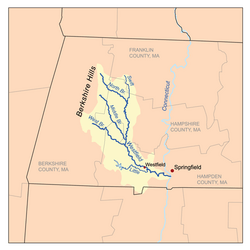Westfield River facts for kids
Quick facts for kids Westfield River |
|
|---|---|

Westfield River in Huntington (the "Main Stem")
|
|

The Westfield River and its major tributaries
|
|
| Other name(s) | Agawam River (archaic) |
| Country | United States |
| State | Massachusetts |
| Region | Metropolitan Springfield |
| District | Hampden County, Massachusetts |
| Municipality | Westfield, Massachusetts |
| Physical characteristics | |
| Main source | North Branch Westfield River Berkshires 1,734 ft (529 m) 42°34′09″N 73°01′54″W / 42.56917°N 73.03167°W |
| River mouth | Connecticut River 39 ft (12 m) 42°05′03″N 72°35′08″W / 42.08417°N 72.58556°W |
| Length | 78.1 mi (125.7 km) |
| Basin features | |
| Basin size | 517 sq mi (1,340 km2) |
| Tributaries |
|
| Type: | Wild, Scenic, Recreational |
| Designated: | November 2, 1993 |
The Westfield River is a big river in western Massachusetts. It flows into the Connecticut River. This river is known for its exciting whitewater rapids and beautiful views. It's a great place for canoeing and kayaking. The Westfield River also has one of the largest wilderness areas in Massachusetts without many roads.
The Westfield River is the longest river that flows into the Connecticut River in Massachusetts. It is about 78.1 miles (125.7 km) long. Even though the Chicopee River carries more water, the Westfield River is still very important.
Years ago, in the mid-1900s, the Westfield River was very dirty. It would even change color because of pollution! But today, the river is much cleaner. It's now safe for swimming. People also enjoy fishing for native trout here. The river flows through pretty mountain areas and old mill towns like Westfield.
History of the Westfield River
When explorers first found this area in 1635, they called the river the "Agawam River." This name came from the Native American tribe who lived there. The city of Springfield was later built where the Westfield River (then called Agawam River) meets the Connecticut River.
It's important not to mix up this "Agawam River" with another river of the same name in southeastern Massachusetts. That other river was named to honor the same Native American tribe.
Branches of the Westfield River
The Westfield River is 78.1 miles (125.7 km) long. It starts in the Berkshire Hills of Massachusetts. From there, it flows southeast until it joins the Connecticut River in Agawam. This is right across from downtown Springfield.
The Westfield River gets its water from a large area of 497 square miles (1,290 km2). This area includes three main branches that come together in Huntington. These branches are:
- The North Branch: This branch starts in Savoy. It flows southeast through towns like Windsor and Cummington.
- The Middle Branch: This branch begins in Peru. It flows southeast through Worthington and Middlefield.
- The West Branch: This branch starts in Washington and Becket. It then flows east through Chester.
These three branches meet in Huntington. The Middle and North Branches join first. Then, about 2 miles (3.2 km) later, they meet the West Branch. The West Branch is special because it's part of the National Wild and Scenic Rivers System.
From Huntington, the main part of the Westfield River flows through Russell and Westfield. It then forms the border between West Springfield and Agawam before reaching the Connecticut River.
Every April, a famous event happens on the Westfield River in Huntington. It's called the Westfield River Whitewater Races. This is the oldest whitewater race in the United States that has been held every year.
Parts of the river are protected as the Westfield Creek Wild and Scenic River. This means they are part of the National Wild and Scenic Rivers System. This system helps keep rivers beautiful and natural for everyone to enjoy.

